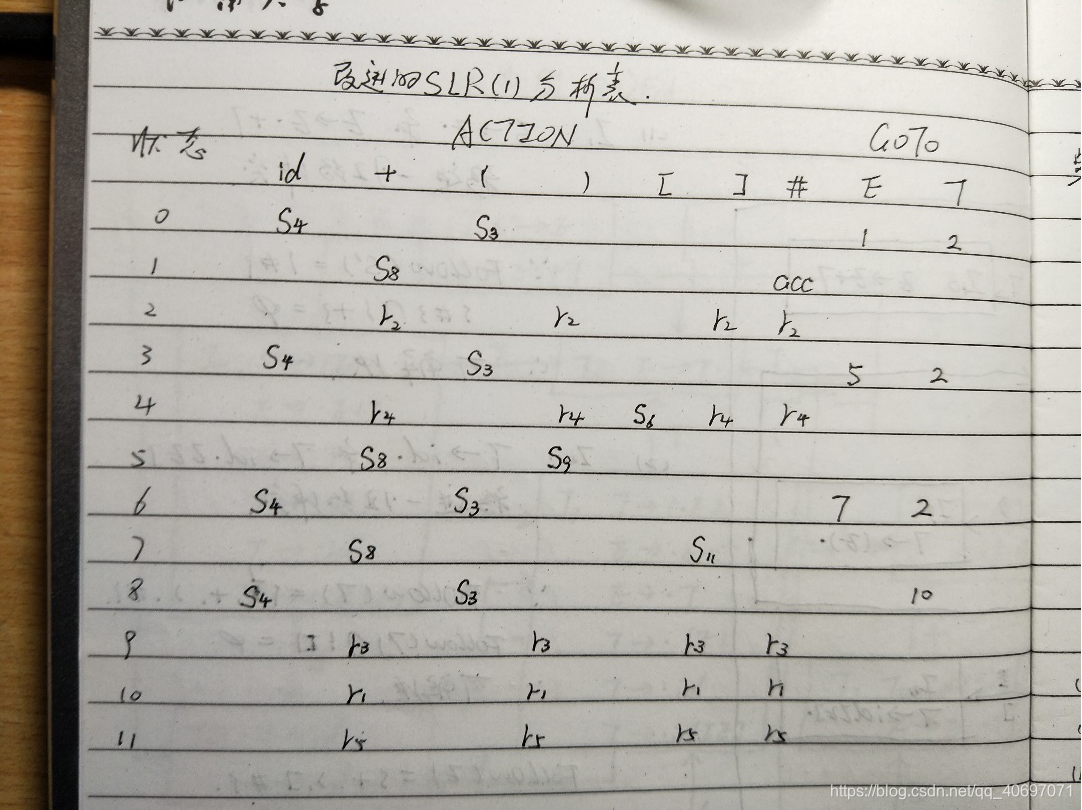文章目录
一、概述
本篇博文主要提供 基于LR分析表编写语法分析器 与 基于WINDOWS下FLEX与BISON的计算器实现 这两个编译原理实验的问题描述、实现流程以及相关实现源码和测试用例。
博客内所有文章均为 原创,所有代码均为 原创,若转载请附原文链接。
二、基于LR分析表编写语法分析器
2.1 需求描述
【问题描述】 已知文法G[E]:
E → E + T | T
T → (E) | id | id[E]
设计LR分析表,并用c++语言编写语法分析器。
【输入形式】 一个句子
【输出形式】 句子语法结构正确,输出“Syntax analysis is right”反之输出“Error on syntax analysis”
【样例输入】 a1+a2
【样例输出】 Syntax analysis is right
2.2 实现流程
- 根据给定文法求其 LR(0) 项目;
- 构造可识别活前缀的 DFA ;
- 绘制 LR(0) 分析表;
- 将 LR(0) 分析表优化为改进后的 SLR(1) 分析表;
- 代码模拟实现自底向上的 SLR(1) 分析 ;
2.3 C++ 源码
#include <iostream>
#include <string>
#include <cstring>
#include <stack>
using namespace std;
const char MOVE_IN = 'S';
const char REDUCTION = 'R';
const string ANALYSIS_TABLE[12][9] = {
{"S4", "", "S3", "", "", "", "", "1", "2"},
{"", "S8", "", "", "", "", "ACC", "", ""},
{"", "R2", "", "R2", "", "R2", "R2", "", ""},
{"S4", "", "S3", "", "", "", "", "5", "2"},
{"", "R4", "", "R4", "S6", "R4", "R4", "", ""},
{"", "S8", "", "S9", "", "", "", "", ""},
{"S4", "", "S3", "", "", "", "", "7", "2"},
{"", "S8", "", "", "", "S11", "", "", ""},
{"S4", "", "S3", "", "", "", "", "", "10"},
{"", "R3", "", "R3", "", "R3", "R3", "", ""},
{"", "R1", "", "R1", "", "R1", "R1", "", ""},
{"", "R5", "", "R5", "", "R5", "R5", "", ""},
};
const string GRAMMAR[6] = {
"S E",
"E E+T",
"E T",
"T (E)",
"T i",
"T i[E]"
};
int get_symbol_index(char symbol) {
int symbol_index = !isalpha(symbol);
if (symbol_index)
{
switch (symbol)
{
case '+':
symbol_index = 1;
break;
case '(':
symbol_index = 2;
break;
case ')':
symbol_index = 3;
break;
case '[':
symbol_index = 4;
break;
case ']':
symbol_index = 5;
break;
case '#':
symbol_index = 6;
break;
default:
symbol_index = -1;
break;
}
}
return symbol_index;
}
void lexical_analysis(char *input_str) {
stack<int> state_stack;
stack<char> symbol_stack;
int symbol_index, state_stack_top, state;
string action;
char action_type;
// init
state_stack.push(0);
symbol_stack.push('#');
while (true) {
symbol_index = get_symbol_index(*input_str);
state_stack_top = state_stack.top();
action = ANALYSIS_TABLE[state_stack_top][symbol_index];
if (action == "ACC" || !action.length())
break;
action_type = action[0];
state = atoi(action.substr(1).c_str());
if (action_type == MOVE_IN)
{
// S
state_stack.push(state);
//input_str++;
if (isalpha(*input_str))
{
symbol_stack.push('i'); // i means id
while (isalpha(*input_str) || isdigit(*input_str) || *input_str == '_')
input_str++;
}
else
{
symbol_stack.push(*input_str);
input_str++;
}
while (isblank(*input_str))
input_str++;
if (!isalpha(*input_str) && *input_str != '_' && *input_str != '+' &&
*input_str != '(' && *input_str != ')' && *input_str != '[' && *input_str != ']' && *input_str != '#')
break;
}
else if (action_type == REDUCTION)
{
// R
string reduction_grammar = GRAMMAR[state];
char reduction_result = reduction_grammar[0];
string reduction = reduction_grammar.substr(2);
for (int i = 0; i < reduction.length(); i++) {
state_stack.pop();
symbol_stack.pop();
}
state_stack_top = state_stack.top();
if (reduction_result == 'E')
state = atoi(ANALYSIS_TABLE[state_stack_top][7].c_str()); // E GOTO
else if (reduction_result == 'T')
state = atoi(ANALYSIS_TABLE[state_stack_top][8].c_str()); // T GOTO
else {
// err
}
state_stack.push(state);
symbol_stack.push(reduction_result);
}
else
{
//err
}
}
if (action == "ACC")
cout << "Syntax analysis is right";
else
cout << "Error on syntax analysis";
}
int main() {
char input_str[100];
cin.getline(input_str, 100);
int len = strlen(input_str);
input_str[len+1] = input_str[len];
input_str[len] = '#';
//char str[] = {'i','+','(','i','+','i' ,')','#'};
lexical_analysis(input_str);
system("pause");
return 0;
}
2.4 测试样例
(1)输入:a1 + a2
输出:Syntax analysis is right
(2)输入:a1 + (a2)
输出:Syntax analysis is right
(3)输入:a1++a2
输出:Error on syntax analysis
(4)输入a1[a2 + a3] + a4 + a5
输出:Syntax analysis is right
(5)输入:a1 + a2[a3] + a4 + (a5 + a6)
输出:Syntax analysis is right
三、基于WINDOWS下FLEX与BISON的计算器实现
3.1 需求描述
【问题描述】 基于词法分析程序自动构造工具Flex与语法分析程序自动构造工具Bison,编制简单的计算器程序。用Flex和Bison实现一个功能更为强大的计算器,尽可能多的包含以下运算(支持浮点数):
a) 加、减、乘、除运算
b) 乘方power、开方sqrt运算
c) 位运算 – 与、或、非…(不做)
d) 三角函数运算 – sin、cos…
e) 求阶乘
f) 求模(不做)
g) 求log以e为底的对数(不做)
h) 求log以10为底的对数
【输入形式】 数学表达式
【输出形式】 表达式的计算结果
【样例输入】 3+5*2
【样例输出】 13
3.2 Flex 源码
// fb1-5.l
%option noyywrap
%{
#define YYSTYPE double
#include"fb1-5.tab.h"
%}
%%
"+" { return ADD; }
"-" { return SUB; }
"*" { return MUL; }
"/" { return DIV; }
"|" { return ABS; }
"(" { return OP; }
")" { return CP; }
"," { return SEG; }
"!" { return FAC;}
"pow" { return POW; }
"sin" { return SIN; }
"cos" { return COS; }
"tan" { return TAN; }
"log" { return LOG; }
"sqrt" { return SQRT; }
""
([0-9]*\.?[0-9]+|[0-9]+\.) { yylval = atof(yytext); return NUMBER;}
\n { return EOL; }
<<EOF>> { return END; }
"//".*
[ \t] { /* ignore white space */ }
. { yyerror("Mystery character%c\n", *yytext); }
%%
3.3 Bison 源码
// fb1-5.y
%{
#define YYSTYPE double
#include<stdio.h>
#include<math.h>
#define PI 3.14159265
%}
/* declare tokens*/
%token NUMBER
%left ADD SUB
%left MUL DIV ABS
%left SQRT POW COS SIN TAN LOG FAC
%token OP CP SEG
%token EOL END
%%
calclist: /*nothing */
| calclist exp EOL { printf("%g", $2); }
| calclist exp END { printf("%g", $2); YYACCEPT;}
| calclist EOL { printf(""); }/* blank line or a comment */
;
exp: factor
| exp ADD exp { $$ = $1 + $3; }
| exp SUB factor { $$ = $1 - $3; }
;
factor: term
| factor MUL term { $$ = $1 * $3; }
| factor DIV term { $$ = $1 / $3; }
;
term: NUMBER
| term FAC {
for(int i=1;i<$1;i++)
$$ *= i;
}
| ABS term { $$ = $2 >= 0? $2 : - $2; }
| SQRT OP exp CP { $$ = sqrt($3); }
| COS OP exp CP { $$ = cos($3*PI/180); }
| SIN OP exp CP { $$ = sin($3*PI/180); }
| TAN OP exp CP { $$ = tan($3*PI/180); }
| LOG OP exp CP { $$ = log10($3); }
| OP exp CP { $$ = $2; }
| POW OP exp SEG exp CP { $$ = pow($3, $5); }
;
%%
main()
{
yyparse();
}
yyerror(char *s)
{
fprintf(stderr, "error: %s\n", s);
}
3.4 测试样例
(1)输入:52+ 21*2 - 2.1
输出:91.9
(2)输入:(252+3)(1-25)
输出:-1272
(3)pow(4,2)+sqrt(144)
输出:28
(4)sin(30)*cos(60)
输出:0.25
(5)输入:log(100)+3!
输出:8
四、相关草图
4.1 可识别活前缀的 DFA 草图

4.2 改进后的 SLR(1) 分析表草图

